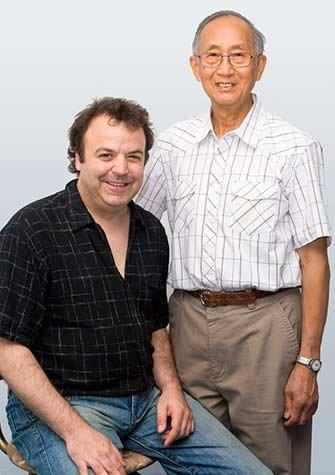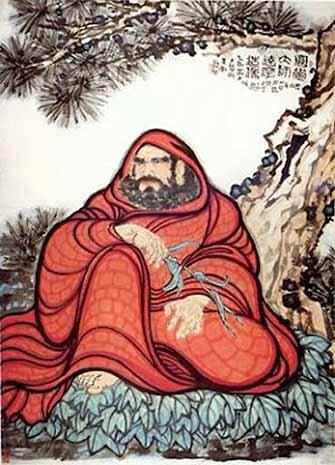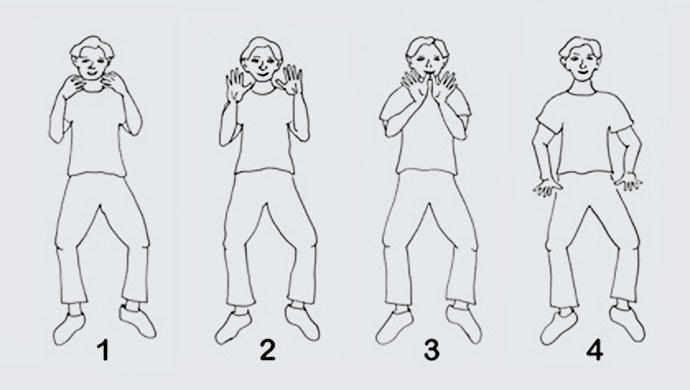In the seventeen years of practicing under Tai Chi master Irving Leong, I remember him suffering from one cold. His immune system seemed to be ironclad. In just a few short years practicing Tai Chi and Qigong with him, I noticed my resistance to colds and flu greatly improved.

Craig Cormack and Irving Leong – Image: Paul Higgins
Qigong (also known as Chi Kung) is defined as ‘breath-work’. Qigong exercises were developed at the time of the Yellow Emperor some 2500 years ago. Qigong was brought to the Shaolin temple by an Indian monk named Bodhidharma, who taught the monks martial arts and Qigong. From these beginnings, Qigong developed over the many years into three major categories: Martial Qigong, Medical Qigong and Qigong for health.
Qigong is an important branch of Chinese Medicine. It’s a gift to practitioners because it is easy to learn and if you practice it you will reap health benefits.
Practicing Qigong builds and circulates energy (Qi or Chi) of the body. Qi is the life force that sustains and animates our bodies. Qi flows through a system of meridians or energy highways to keep the body stabilized, healthy and protected. Chinese medicine describes meridians as a stream. If this Qi flows unimpeded, we stay healthy, if it becomes blocked it stagnates leading to illness.
There four major kinds of Qi in the body. The first kind is Prenatal Qi (Yuan Chi). This is the Qi we inherit from our parents upon conception. Known as ‘Kidney Chi’, it resides in the adrenals. The adrenals, in terms of Qi, serve as rechargeable batteries. The actual energy is used to help us grow and develop into people. Yuan energy is finite and eventually, we run out of it. The good news is that we can replace some of this by practicing Qigong. It is through this practice we sustain energy, prevent illness, and slow the ageing process. Many masters in China practice Tai Chi and Qigong into their 90s because of their abundance of Qi leading to remarkable health.
In just a few short years practicing Tai Chi and Qigong… I noticed my resistance to colds and flu greatly improved.
The second kind of Qi is Nutritional Qi (Ying Chi). This is the Qi we get from ingesting food. This Qi is produced from the stomach and spleen. Ying Chi produces blood and provides the body with nourishment. The food is transformed with the oxygen we breathe. Qi is called the commander of blood, but blood is the mother of Qi. Qigong exercises help in this transformation through the breathing exercises. Blood and Qi have a reciprocal relationship very often referred to as dancing partners (or husband and wife) in their Yin Yang dance.

Bodhidharma – Image: public domain
The third kind is known as Defensive Qi (Wei Chi). Defensive Qi is also formed from the food we eat. This Qi sits on the surface of the body as a thin coating, which protects us against disease. Wei Chi protects us from extreme cold, damp, dryness, wind and other evils. Wei Chi operates our pores, provides moisture to the skin and hair and regulates body temperature. Wei Chi is our protective shield.
The fourth kind of Qi is called Pectoral Qi (Zong Chi). Qigong drives this type of Qi into the lungs and helps the heart circulate the blood. This Qi gives the body stamina. A weakness in this Qi is often reflected in a person’s weakness of voice.
Qigong works by supporting the four kinds of Qi. The Yuan Chi is directly affected by Qigong because exercises drive the energy through the meridians and work to recharge the adrenal glands. By practicing Qigong, you also reduce cortisol levels in the adrenals by reinforcing the relaxation of the body.
Nutritional Qi is transformed by the breath. Since Qigong is based on breathing exercises it aids tremendously in this process. Breathing transforms food and liquids into the energy of the body.
Wei Chi is developed through movement. By practicing Tai Chi and Qigong you build up surface or Protective Qi.
And Zong Qi is directly built up by the breathing exercises in Qigong.
STUDIES ON QIGONG AND IMMUNITY
The American Journal of Chinese Medicine published a study including fifty seniors. 27 were in the Tai Chi/Qigong group and 23 were in the control group. All subjects received the 2003-2004 influenza vaccine. The Tai Chi/Qigong group reported a much higher antibody result. The authors concluded that Tai Chi/Qigong “improves the antibody response to influenza vaccine in older adults.”¹
In a study looking directly at the effect of Qigong on immunity, blood cells were measured pre and post-intervention. Researchers found that “white blood cells increased significantly two hours after actual Qigong training… monocyte numbers were significantly increased after training… natural killer cell numbers decreased… the data indicate that a single Qigong intervention can increase the monocyte and lymphocyte numbers.”²
‘Mind-body therapies reduce markers of inflammation and influence virus-specific immune responses to vaccination.’
In a study published by the American Psychological Association, mind-body studies featuring Tai Chi, Qigong, meditation and yoga were compiled and studied. The authors found that C-reactive protein was reduced in most studies. C-reactive protein measures inflammation and is indicative of disease, a reduction of interleukin-6. Their conclusion was that mind-body therapies reduce markers of inflammation and influence virus-specific immune responses to vaccination.³
In another study on Qigong training on stress hormonal levels, researchers found that the level of beta-endorphin significantly increased, and the level of ACTH declined.4 Researchers concluded that Qigong training plays a role in hormonal regulation.
Kenneth Sancier, a former researcher from Stanford Institute and Chairman for the QiGong Institute, has published a compendium of studies on the anti-ageing benefits of Qigong. He has been studying Qigong, using his analytical skills since 1986. He has assembled a computerized database with over 3,500 citations of Qigong. Many of these studies were published only in China and only recently have been translated.
SYNOPSIS OF SCIENTIFIC RESEARCH COMPILED BY SANCIER 5
Long-term balance of blood pressure in hypertensive patients
A 30-year study on 242 patients conducted by Wang, Xu, and co-workers of the Shanghai Institute found that those who practiced Qigong faired better than their control counterparts. Both groups took medication to control their blood pressure and no one smoked in either group. Wan, Xu found that over the 30-year study the Qigong group could reduce their medication while those in the control had to increase their medication.
Mortality and stroke
A 30-year study showed that Qigong exercise resulted in a decrease of 50% in terms of total mortality, mortality due to stroke, and morbidity due to a stroke. At the end of 30 years, 86 patients survived in the Qigong group and 68 in the control group.
‘Results show that practicing Chi Kung was superior to walking or running in reducing symptoms of ageing and senility.’
Improvements in heart function and microcirculation
Sancier reports, “Aged hypertensive patients usually are found to have a deficiency of heart energy, which often leads to a weakened function of the left ventricle and disturbance of microcirculation.” A study was conducted on 120 aged patients using ultrasonic cardiographs and indices on microcirculation. Researchers found the hypertensive group (80) patients improved their heart function by 50% after just one year of practice of Qigong.
Improvements in sex hormone levels
Levels of estrogen increase in men as they age and decrease in women as they age. Practicing Qigong reduces estrogen in men and increases it in women.
Reverses symptoms of senility
A study was conducted of 100 senile and pre-senile patients divided in half (50 control, 50 experiment). After six-months of Qigong, the experimental group improved by 80% whereas the control group improved by 45%. These results show that practicing Qigong was superior to walking or running in reducing symptoms of ageing and senility.
Qigong increases Superoxide Dismutase or (SOD)
SOD is known as the anti-ageing enzyme because it helps destroy free radicals, which cause ageing. As we age, we produce less SOD. A study was conducted of 200 retired workers consisting of 100 males and 100 females divided equally into 2 groups. Researchers found higher SOD levels in the Qigong group than the control group.
IMPROVEMENT IN CARDIOVASCULAR FUNCTION
Qigong improves blood flow to the brain
In one study with 158 patients with cerebral arteriosclerosis who practice Qigong for one to six months, improvements were noticed in symptoms such as memory, dizziness, insomnia, tinnitus, numbness of limbs and vertigo headache. A decrease in plasma cholesterol was also noted.
‘I recommend that when you are first learning Qigong you should find a qualified teacher to teach you the foundation. You then can move safely on to learning from books and videos.’
TWO MAJOR KINDS OF QIGONG
Qigong comes in two varieties, active and passive. Active Qigong comes in the form of exercises involving the movement of arms and legs in concert with breathing. Weight shifting with movement is also employed.
Meditative Qigong takes the form of meditation and holding postures. Meditative Qigong is performed sitting usually and practitioners are trained to use their imaginations to move the Qi with their will in different directions of the body. Also, practitioners are trained to bring Qi from the outside world into the body. Passive Qigong with postures includes holding standing positions for a fixed number of breaths or seconds. This kind of Qigong is featured in Martial Arts Qigong because holding postures makes you strong internally as it requires stamina to hold fixed positions and it increases your strength and endurance.
A SIMPLE QIGONG EXERCISE
For readers interested in trying a simple Qigong exercise this article includes instruction on the four posts.

Image: courtesy of Carina Rose (carinarose.com)
Picture 1
For the first post, you need to stand in the horse stance. The horse stance is accomplished by standing with your legs far apart as if you are sitting on a saddle on horseback. Bend your knees, lower your rear end and straighten your feet. Also, your back should be straight. Raise your arms as if you are hugging someone. Your elbows should be pointed downward and your fingers on both hands should be pointed towards each other.
Picture 2
Continuing holding the horse stance. The second post is very much the same as the first post except now you extend your arms out and your palms forward. Push just your palms forward and concentrate on the stretch happening between your palms and your shoulder blades.
Picture 3
Continue the horse stance. The third post involves bringing your elbows together and pushing your palms outward.
Picture 4
Continue the horse stance. The fourth post involves pushing your palms downward, at the same time pushing up from your feet, creating a counter stretch. This also creates space in your vertebrae.
Qigong is a gift to everyone. There are complicated forms and easy forms available to learn. As Master Irving Leong said, “the good measure of any system is that it is simple, safe and effective. The system should be simple to learn, safe to do, and give you results.” I recommend that when you are first learning Qigong you should find a qualified teacher to teach you the foundation. You then can move safely on to learning from books and videos.
- Effects of a Taiji and Qigong Intervention on the Antibody Response to Influenza Vaccine in Older Adults
Yang Yan, Verkullan Jay, Rosengren Karl S, Mariani Rachel A, Reed Michael, Grubisich Scott A, Woods Jeffrey A.
The American Journal of Chinese Medicine, Vol 35, No 4, pp 597-607 (2007)
. - Effects of Qigong on Immune Cells
Lee Myeong Soo, Huh Hia Jiang, Jeong Seong Min, Jan Hye-Sook, Ryu Hoon, Park Jae-Hwang, Chung Hun-Taeg, Woo Won-Hong
The American Journal of Chinese Medicine, Vol 31, No.2, pp 327-335 (2003)
. - The Effects of Mind-body Therapies on the Immune System: Meta-analysis
Morgan N, Irwin M, Chung M, Wang C.
Journal Article Database: APA PsychInfo (2014)
. - Acute Effect of Qigong Training on Stress Hormonal levels in Man
Ryu Hoon, Lee Ho-Sub, Shin Youn-Sib, Chung Seong-Min, Lee Myeong-Soo, Kim Hyung-Min, Chung Hun Taeg
The American Journal of Chinese Medicine, Vol 24, No 2, pp 193-198 (1996)
. - researchgate.net/scientific-contributions/11171343_Kenneth_M_Sancier